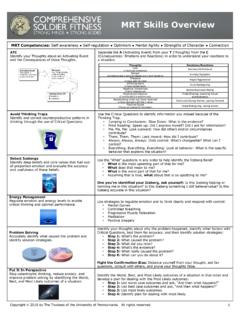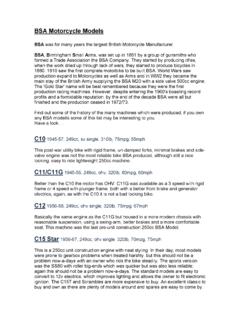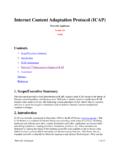Transcription of VESTIBULAR DYSFUNCTION ASSOCIATED WITH BLAST …
1 VESTIBULAR DYSFUNCTION ASSOCIATED with BLAST INJURIES OBJECTIVES Understand the mechanism of injury behind Traumatic Brain Injury BLAST Injuries Recognize Signs and Symptoms ASSOCIATED with BLAST Injuries Understand the need for assessment and treatment of VESTIBULAR DYSFUNCTION in this patient population OCCURRENCE In 2009 Pentagon released that up to 360,000 veterans of the wars in Iraq and Afghanistan have suffered Brain Injuries Of those veterans, 90% are so called mild cases and recovery is expected. Estimated 45,000 to 60,000 victims however suffer persistent symptoms such as memory loss, lack of balance and problem solving difficulties These numbers may be a lot higher secondary to difficulty monitoring the injuries and the failure to report mild concussive injuries TRAUMATIC BRAIN INJURY Is the result of a blow or jolt to the head or a penetrating head injury that disrupts the function of the brain.
2 Mild Injury: a brief change in mental status or consciousness Severe Injury: an extended period of unconsciousness or amnesia after the injury LEADING CAUSES OF TBI IN THE MILITARY Bullets, fragments, blasts Falls Motor vehicle- traffic crashes Assaults Blasts are the leading cause of TBI for Active Duty Military in war zones WHAT IS THE VESTIBULAR SYSTEM? Provides information concerning gravity, rotation and acceleration for the body in space Serves as a reference for the somatosensory & visual systems Contributes to integration of arousal, conscious awareness of the body via connections with the brain Allows for.
3 Gaze & postural stability sense of orientation detection of movement of body in different planes NON BLAST RELATED TBI INJURY 80% reported dizziness VESTIBULAR pathology present in 30-65% of individuals VESTIBULAR screening needs to be done in all patient's with TBI WHY IS THE VESTIBULAR COMPONENT SO COMPLICATED? No objective evidence in humans to support the theory that blasts cause neuronal damage and subsequent brain injury Dizziness is subjective Incidences of dizziness, VESTIBULAR pathology and TBI secondary to BLAST injury is unknown Complicated by physical and psychological stresses ASSOCIATED with injuries in a war zone Debate on whether symptoms ASSOCIATED with mTBI originate from pathophysiological process or from psychosomatic WHAT IS A BLAST INJURY?
4 Primary: injuries from impact or shearing from overpressure wave Secondary: injuries from projectiles (shrapnel or debris) Tertiary: injury from displacement of the individual by BLAST wind Quaternary: other injuries PRIMARY INJURY Caused by barotrauma, attributable to either overpressurization or underpressurization relative to the atmospheric pressure Affect the hallow organs in the chest abdomen and middle ear as well as great vessels in neck, inner ear and possible the brain Inner ear trauma is common- considered a sensitive indicator of BLAST exposure with 35-50% experiencing some sort of hearing loss 15-40% complain of dizziness or vertigo CLOSED HEAD INJURY RELATED TO BLAST Diffuse axonal injury.
5 Contusion and subdural hemorrhage Axonal injury is the most common frequently ASSOCIATED with mTBI and characterizes the vast majority of BLAST injuries sustained by service members Occurs when shearing, stretching or traction on small nerves leads to impaired axonal transport, focal axonal swelling and possible axonal disconnection MRI/CT inconclusive SYMPTOMS ASSOCIATED with MTBI Headaches Dizziness Excessive fatique (tiredness) Difficulty concentrating Forgetfulness Irritability Balance problems Vision changes Sleep disturbance VESTIBULAR PATHOLOGY AFTER HEAD TRAUMA Temporal bone fractures Labryinthine concussion Post traumatic endolymphatic hydrops Benign paroxysmal positional vertigo (BPPV) Perilymphatic fistula Vascular or central lesions CHARACTERISTIC S AND SENSORIMOTOR DEFICITS Reports of dizziness , vertigo and Oscillopsia (blurry vision)
6 In days/weeks after BLAST injury and persistence of symptoms for ongoing months Symptoms sometimes not noticed until redeployment and in home environment Recent studies show a total of 71% of survivors with initial complaints of dizziness continued to be symptomatic > 6 months Feeling of off balance or postural instability, hearing loss, light sensitivity and inability to read for long durations WHAT DOES THIS MEAN FOR CLINICAL PRACTICE? Comprehensive assessment is needed to identify exact deficits Rule out differential diagnosis such as vascular compromise (vertebral a), C1/C2 involvement, cervico-genic/postural deficit or orthostatic hypotension Currently there is no gold standard and no agreement about diagnostic measures for BLAST related dizziness Rehab community has an opportunity to contribute data toward a consensus on optimal diagnostic and treatment practices REFERRAL TO VESTIBULAR REHAB Screenings done by TBI clinics on Military Installations MACE (Military Acute Concussion Evaluation)
7 And the BLAST Injury Questionnaire are useful for directing the initial screening and characterization of patients with BLAST exposure and suspected TBI or VESTIBULAR pathology Dizziness Handicap Inventory and Activities-specific Balance Confidence Scale provide insight into a patient's self perceived limitations Pre-deployment and post deployment questionnaires are now being completed. PHYSICAL THERAPY ASSESSMENT History and Subjective Document patient's functional problems and the many sensory, motor and cognitive limitations contributing to loss of functional independence When are they experiencing dizziness/vertigo or imbalance or what provokes symptoms Other complaints and symptoms such as headaches/light sensitivity, cognitive impairments, insomnia, depression.
8 Anxiety or agitation PHYSICAL THERAPY ASSESSMENT Physical exam Cervical Spine ROM/Limitations C1/C2 mobility Vertebral artery compression test Postural deficits/muscular imbalances Visual/ VESTIBULAR system examination (Eye Head Coordination) Oculo-motor ROM Nystagmus both fixed gaze and head shaking Smooth Pursuits Vestibulo-Occular Reflex of VOR Dynamic Visual Acuity (DVA) PHYSICAL THERAPY ASSESSMENT Vertigo assessment/Motion sensitivity Spontaneous Provoked: positional changes Hallpike Dix Test Movement or motion sensitivity Postural Control/Balance in sitting/standing and walking Rhomberg, Sharpened Rhomberg, Single Leg Stance Ambulation with head turns Quick Ambulation with Quick changes in position Stair negotiation BERG balance exam/Dynamic Gait Index (DGI)
9 Sensory Organization Test/Balance Master MAKING SENSE OF IT ALL Sorting out the relative contribution of VESTIBULAR pathology to overall loss of function can be difficult Functional deficits after TBI are usually due to combination of many interacting factors Rule of thumb; treat the symptoms! PHYSICAL THERAPY MANAGEMENT Individualized treatment plans based on symptoms and objective findings Recent finding show significant improvement in all areas of VESTIBULAR rehab after 8-12 weeks of VESTIBULAR physical therapy Marked decreases in subjective reports of dizziness and headaches and feeling of off balance as well Objective measures such as DGI and SOT scores significantly improved after 12 weeks RECOVERY FROM TBI Plenty of sleep at night and rest during day Return to normal activities gradually Avoid exposure to high risk activities until healing has
10 Occurred (recreational sports etc) Avoid alcohol- slows brain recovery Use strategies to aid in memory impairment Use structure and routine each day One thing at a time for better focus less distractability Use relaxation techniques, yoga, meditation for irritability and remove self from situations Be patient! It will take time! RETURN TO DUTY Too soon can cause temporary worsening of symptoms if brain is not fully healed Physical Exertion tests are helpful in gauging if symptoms will re-occur Gradually resuming duties may be helpful Shortened work day Allow for breaks when symptoms increase Reduced task assignments and responsibilities WHERE DO WE GO FROM HERE?




